Après avoir ouvert un sujet de discussion sur l'hypothèse d'une origine anglaise des L'Haridon, qui a donné lieu à d'intéressantes contributions sur la toponymie, il me semble pertinent d'en faire un sujet dédié, faisant aussi appel à la linguistique.
Et pour répondre à la demande de Christian, je transfère ici les informations relatives aux lieux identifiés en Angleterre et en Normandie, ainsi qu'aux personnes portant le nom de ces localités et l'évolution de la prononciation & graphie.
Les lieux nommés Haredon - Harwedon - Haridon semblent constitutifs d'une toponymie anglo-normande.
1/ En Angleterre
A- Haredone (forêt de Savernake, co. Wiltshire)
1086 (Domesday Book) : un lieu appelé "Haredone" (dont Richard Sturmy est le 'tenant-in-chief')

1130 : première personne identifiée portant ce nom
Adam de Haredena reddit compotum de .xx. s. de eisdem placitis [Forestar’]. In thesauro liberauit. Et Quietus est.
Adam de Haredena reddit compotum de firma terre Ricardi Esturmit. In thesauro .c. et .xvij. s.
Et Quietus est.
1249 : début de généalogie avec Richard de Haredon possédant la terre du même nom et la garde de la forêt de Bedwin.
Richard de Haredon (alias Hardon, aussi écrit Harden), décédé en 1249, tenait du Roi environ 1 hectare de terres « by the service of keeping the woods of Bedewinde ». Il détenait aussi ~35 hectares dans la même localité de Hardon (Harden) « by the service of finding one man with one horse of the price of half a mark with one sumptuary saddle, and one sack of grain at Wales for the King’s army when the King shall have an army there ».


Richard de Harden(e), décédé lui en 1294, (fils de John et neveu de Roger) possédait à sa mort une partie des terres dans la même localité de Harden associées au « bailiwick of the King’s forest of Savernake which is called Broyl de Bedewynd ». Il détenait également d’autres terres à Harden(e) « by the service of finding one man with one horse and a certain sack for cloths at his own costs for 40 days in the time of war ».

William de Harden(e), décédé en 1303, possédait lui aussi des terres à Harden(e) « by the service of keeping one part of the forest of Savernaks which is called Broyl de Bedewinde » ainsi que près de 50 hectares à Shaldebourn « by the service of the moiety of one serjeanty in the King’s army, to wit, finding the moiety of one man armed with a habergeon, lance, and helmet of iron for 40 days at the charges of the said William ».
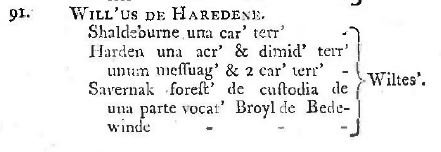
La plus illustre figure de cette famille semble être Sir William de Harden(e) (dont le premier Richard cité est le grand père), décédé en 1330, fait chevalier (knight) en 1306 à Whitsuntide, « on the occasion of the knighting of Edward, prince of Wales, afterwards Edward II ». En 1307, il représente le comté de Wiltshire à Westminster au parlement anglais.
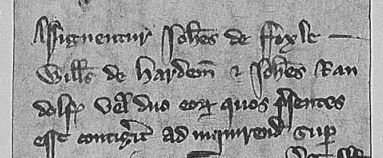
(1317)
Il tenait du roi le fief de Westshaldebourne « by the serjeanty of finding one footman, armed with one ‘haubergell’ and one iron knife and one lance in the King’s war, at his own expense, for 40 days for all service ».
Il possédait aussi des terres à Estwyke « by the service of keeping half of a certain part of the forest of Savernake, which is called ‘la Westbaillye’ ». Le terrain est dit semé de blé.
D’autres terres semées dans la même localité lui appartenaient « by keeping the other moiety of ‘la Westbaillye’ ».
Dans la forêt de Savernake, il tenait de la Reine plus de 150 hectares de terres défrichées lui valant 6£.
Il tenait aussi de Roger de Harden 16 hectares de terre à Harden.
Ledit Roger, décédé en 1331, tenait en fief des terres arables et « the bailiwick of the forestry of a certain part of Savernake, called ‘Broyl de Bechewynde’ » ainsi que 60 hectares de prairie, pâturage et bois à Harden(e).
En 1361, on peut lire (dans la transcription anglaise des registres)
« William de Hardene and her ancestors have held from time immemorial the west bailiwick of the said forest [Savernake] jointly with William de Boneclif and his ancestors ». Anastasia (daughter and heir of William) « and her ancestors have held a virgate of land under the covert of Iwode for keeping the said bailiwick, and William Boneclif and his ancestors a virgate called Boneclive ».
La forêt avait été divisée en plusieurs bailliages (Harding est le nom actuel du lieu appelé « Haredone » en 1086) : « Savernake Forest was defined by its boundaries and protected by Forest Law. It was divided into several bailiwicks, the largest being the West bailiwick, and the smallest, Southgrove. The Broyle or Brail, was managed by the Harden foresters of Harding, and La Verme bailiwick was directly managed by the warden. »
Guillaume le Conquérant fit « borner la forêt de Savernake pour en faire l’une de ses chasses favorites ».
Les Esturmy (Sturmy) étaient « warden » de la forêt royale de Savernake.
Dans le Domesday Book de 1086, Ricardus Sturmid (Richard Sturmy) est « ministri regis ». Son nom figure (Richard l’Estourmi) en l’église Notre-Dame de Dives-sur-Mer sur la liste des « compagnons de Guillaume à la conquête de l’Angleterre en 1066 ».
Après la victoire décisive d’Hastings et la conquête du royaume, en récompense il reçoit du nouveau roi d’Angleterre, des terres à Cowlestone (Cowesfield), Buberge (Burbage), Grastone (Grafton), Haredone (Harding), Saldeborne (Shalbourne), Iwis (Huish).
Il en est le ‘tenant-in-chief’ mais à Haredone, le Domesday Book nous apprend que Robe (Robert) est ‘under-tenant’.
Les Hardon (Harden) et Boneclif (Boneclyve) tenaient du Roi un bailliage de « royal foresters » dans la partie « West ».
« Haredone » et « Boneclive » sont des lieux se trouvant dans cette forêt et les « foresters » portent ces noms (« de Hardon (ou Harden)», « de Boneclif »).
‘Warden’ : souvent une personnalité éminente, il était personnellement garant du respect de la loi forestière et supervisait les forestiers.
‘Foresters’ : ils assuraient la protection de la forêt, faisaient appliquer et respecter la loi forestière, appréhendaient les auteurs d’infractions.
B- Haredon (co. Devon)
En 1332, « the Devonshire lay subsidy » mentionne les noms de Henry de Haredon et William de Haredon à Uggeburgh (actuel Ugborough).
Dans cette localité, on trouve un lieu appelé Haredon. Par exemple, un bail daté du 6 octobre 1381 « of one piece of land in Haredon (Upharedon) in the manor of Ugborough (Uggaburh) » en présence de John de Haredon.
Aujourd’hui encore existe à Ugborough :
« Haredon farmhouse. Haredon is an important and remarkably unaltered late mediaeval house. »
On dispose, pour le comté de Devon, de listes détaillées des contribuables pour les années 1332, 1524 et 1544, et d’un recensement en 1569 des hommes et des équipements en cas de guerre.
En 1524, on trouve au sud-est de ce comté :
Charleton
- Roger Haredon
- Robert Haredon
Paignton
- Ambrose Harydon
South Brent
- Richard Haredon
Ugborough
- William Hardon
West Alvington
- Henry Harydon
- William Harydon
- John Harydon
- Walter Harrydon
- William Harrydon
- John Harrydon
Je précise qu’il s’agit bien de sujets anglais car lorsqu’il s’agissait d’étrangers, la mention « alien » était ajoutée.
En 1544, 20 ans plus tard, la situation est la suivante :
Charleton
- Robert Haradon
- Roger Haradon
Chivelstone
- John Haradon
Dartmouth
- John Haredon
Dean Pryor
- Nicholas Hardon
Paington
- Ann Haradon
- John Haradon
West Alvington
- William Haridon
- John Harydon
- Richard Harydon
A propos de John Haradon de Dartmouth, on trouve son nom dans les « churchwarden’s accounts » de l'église St. Saviour, écrit successivement : Harydon (1533), Haredon (1534, 37 et 38), Harydon (1539).
C- Harwedon (co. Northamptonshire)
Je reprends ici des informations de Christian.
Le cartographe écossais John Ogilby (1600–1676) s’est rendu célèbre par la parution de l’un des premiers atlas routiers anglais : le Britannia Atlas de 1675 (seconde édition parue en 1698).
Sur cet extrait de la carte 47 décrivant « The Road from London to Oakham. St. Albans, Bedford, Wellingborough, Kettering, Uppingham, Oakham », on distingue en haut à gauche les localités de Haridon Parva et Haridon Ye Great, situées sur la route qui va de Kettering à Wellingborough dans le comté de Northampton (Northamptonshire).

Le nom de la localité Great Harrowden (Haridon Ye Great vers 1675) a évolué dans le temps : Hargindone, Hargedone (11ème siècle); Harudon (12ème siècle); Magna Harwedone, Harewedon (13ème siècle); Much Harowdon, Harrodon (16ème siècle); et donc Haridon (17ème siècle).
Ces deux localités sont aussi souvent dénommées Harrowdens (Little et Great Harrowden, Harrowden Parva et Magna).
Hormis les Vaux de Harrowden, une ou plusieurs familles installées antérieurement aux Vaux ont porté les différents toponymes associés à ces deux lieux, comme le montrent les extraits de chartes ci-dessous. Toujours dans la généalogie de la famille de Vaux évoquée précédemment, on peut d’ailleurs remarquer en page 4 le mariage d’une Margaret de Vaux of Harrowden avec un William Harrowden.
A noter : le nom Harrowden est ici la forme moderne, dans les actes que j'ai trouvés, concernant ce mariage, le nom est écrit Harwedon.
Dans « The Knightley Collection of Charters - 1150 - 1684 Northamptonshire », on trouve quelques références à ces toponymes, ainsi que les diverses variations évoquées précédemment :
- Covenant of lease by Adam de Harudon and Alice his wife to Richard Mountoutte of Little Harwedon. Rent, one penny at Easter. Witness Robert de Orlingbere, gilbert le Dyne, Seer de Raundys. Dat. Great Harwedon, S. aft. F. of St. Hilary [13th January] 24 Edward I - item | K(C)/026 - 13th Century
- Grant by Dom. Sayer de Raund, Knt., to Richard de Harewedon and Mabel his wife of a messuage in Little Harewedon. Witness Ralph de Bokenor, John de Aston, Knts., Dat. Raund, Fr. aft. Exalt. of Holy Cross [14 th September] 32 Edward I [1304] - item | K(C)/032 - Early 14th Century
- Final concord made in Trinity Term at Westminster, whereby John de Harwedon, parson of the church of Stoke Bruere by William de Holecote his attorney receives from William Grey of Stoke Bruere and Agnes his wife, the conveyance of a messuage, and three and a half acres of land in Stoke Bruere {Bruerne]. Dat Trin Term 19 Edw II [1326] - item | K(C)/063 - 14th Century
- Lease, for lives, by William son of Richard de Harndon[Harrowden] to Richard de Bengworth, living in Orlingbury, and Isabella his wife, of lands in Orlingham [Orlingbury]. Rent two silver marks. Witness Richard de Bronton, John Howe, etc. Dat Orlingbury F of St Ambrose [4th April] 4 Edw III [1331] - item | K(C)/069 -14th Century
- Grant by William Budde, of Withemale to William de Harwedon, Joan his wife, and John their son of the reversion of certain tenements in Withemale and Orlingbury, which Peter Barre, Robert son of Richard and Amabel his wife and others hold for their lives. Witness Dom. John de Sancto Mauro, John de Leukenor, Henry de Isam, etc. Dat Harwedon [Harrowden] Saturday before F of St Giles [1st September] 5 Edw III [1331] - item | K(C)/070 - 14th Century
- Grant by John de la Leye of Shuttlehanger to Adam de Cortenhale and Margery his wife, of two parts of a messuage in Shuttelhanger, with the reversion of the third part. Witness Robert de Harewedone, Thomas de Bosento, John Engelond, etc. Dat. F of St Peter-in-cathedra [22nd February] 6 Edw. III [1332] - item | K(C)/071 -14th Century
- Lease, for lives, by William de Harudon Magna to John le Deyster, Alice his wife, and John their son, of a watermill called Wetemill (?). Witness Henry le Chapman, William Hynes etc. Dat. Saturday after F of St Matthias [24th February] 27 Edw III [1353]. Mutilated. - item | K(C)/091 - 14th Century
- Copy of the King's writ granting to Simon Simeon and Elizabeth his wife, free warren in the manors of Harrowden and Thyndon (County Northamptonshire) Dat. Oseney, by Oxford, [8th August]. 10 Ric. II [1386]. - item | K(C)/112 - 14th Century
- Lease by Isabella Seint Johan, widow of William Seint Johan, of Plumpton, to William Harowdon, of Harowdon Magna, and Margery his wife, daughter and heir of the late Giles Seint Johan, Knt., of the manor of Middleton Cheynduit [Middleton Cheney]. Rent, 20 marks. Witness John Harewedon, Robert Haldenby, Ralph Parles, etc. Dat. S.before F of St James [25th July] 16 Ric II [1392]. On the back: Copy of power of attorney from the King (Richard II) to William Stowe and others to deliver seisin to the Prior and Convent of the "House of Salvation of the Mother of God" of the Carthusian order, near the City of London, of the above-named Manor. - item | K(C)/120 - 14th Century
- Grant by John Poynt, of Harrowden Magna, and Emma his sister, to William Harwedon and William his son, of an acre of land in the fields of Great Harrowden. Witness William Yonge, William Thong, Nicholas Drinkwater. Dat. Harrowden, Tuesday before F of St Michael {29th September] 3 Henry IV [1402] Seal. - item | K(C)/129 - 15th Century
- Quitclaim by William Thounge, of Harrowden Magna, to William Harwedon, sen., Margery his wife, and William Harwedon, jun. of half an acre in the fields of Harrowden, late belonging to Henry Sulby at Wrythewelle dam, and granted to the same William, Margery and William by Robert Wyngrave of Higham Ferrers. Witness Thomas Dowce, vicar of Harrowden, etc. Dat. S. before. F of Nat. of St John Baptist [24th June] 9 Henry V [1421] Seal. - item | K(C)/159 - 15th Century
- Inspeximus by King Henry VI, on the requisition of William Harewedon, esquire, and Margery his wife, of a suit heard at Northampton in the 3rd year of Edward III between that King and Adam de Cortynhale on a plea "quo waranto" wherein the latter claimed to have view of frankpledge, infangenthef and wayf, issuing from the manor of Stoke Bruere [Stoke Bruerne]. Dat. [15th November] 11 Henry VI [1432]. Great seal, chipped. - item | K(C)/187 - 15th Century
- Copy of the King's writ to the Sheriff of County of Northampton, concerning certain beasts and cattle, of Margery, widow of William Harwedon with the enquiry taken before a jury concerning the same. Dat. [31st January]. 16 Henry VI [1438] - item | K(C)/199 - 15th Century
- Grant by Walter Germeyn, of Browton {Broughton], to Margery Harwedon and William Harwedon, of a toft with croft, etc., in Orlingbury. Dat. Tuesday after F.of St Mark [25th April] 18 Henry VI [1440].Seal. - item | K(C)/203 - 15th Century
- Grant by Isabella Skynnard, of London, widow, to William Furthe, esquire, John Ayleward, Rector of Stoke Bruere [Stoke Bruerne], and Thomas Peyntour, vicar of Harrowden, of all her lands, rents, etc., in alderton, Stoke Bruere, Shuttlehanger, Twyford, and elsewhere in County Northampton, which she formerly held jointly with Henry Hamond, clerk, John Faune, citizen and skinner, of London, etc. Dat. Alderton, Monday before F. of St Margaret [20th July]. 21 Henry VI [1443]. Seal - item | K(C)/204 - 15th Century
- Grant by Valentine Knightley, esquire, in pursuance with the terms of the will of Sir Richard Knightley, his father, to his brother, John Knightley, clerk, Dean of the Collegiate Church of Warwick, of an annuity of £40 from the issues of the Manors of Everdon, Moreton Pinckney [Moreton Pinkney], Great and Little Harrowden, of which Sir Edmund Knyghtley, Knt., at present stands seised, but which on his death without male heir should remain to the said Valentine. Dat. [5th September] 34 Henry VIII [1542]. Seal - item | K(C)/307 - 16th Century
Je complète avec des informations relevées ensuite pour ce comté :
- En 1286 : Walter de Harudon, of Esseby (Ashby)
- En 1291 : William de Harudon, of Esseby (Ashby)
- En 1292 : Robert de Harwedon, clerk, rector of Finedon (1296-1317). En 1299, il obtient le bailiwick de la forêt de Bernwood.
- En 1296 : Adam de Harudon (à Great Harwedon)
- En 1301 : John de Haruden (Irthlingborough) et Henry de Harudon (Finedon)
D- Harwedon (co. Bedfordshire)
On l'a vu dans le Northamptonshire, une localité Harwedon devenue Harrowden. On trouve un toponyme identique dans le Bedfordshire.
Et l'évolution, notée par Christian, de Harwedon vers Haridon expliquerait peut-être la graphie Haridon dans les registres paroissiaux de Northill situé à moins de 10 km de Harwedon/Harrowden.
Baptêmes
1563 - Robert fils de John Harryson
1572 - Thomas fils de Hugh Harrydon
1573 - William fils de Hugh Harrydon
1576 - Martha fille de William Harrydon
1577 - John fils de Hugh Harridon
1597 - Katherine fille de Nicholas Haridon
1605 - Stephen fils de William Harryden
1607 - Margaret fille de William Harrodon
1610 - William fils de William Harrodon
1612 - Lewis fils de William Haredon
1616 - Katherine fille de William Haredon
1619 - Abigail fille de William Haredon
1619 - Agnes fille de William Harrison
1619 - Mary fille de William Harrison
1621 - Elizabeth fille de William Harrison
1622 - Alice fille de William Haredon
1625 - Thomas fils de --- Hardon
1625 - William fils de William Harrison
1625 - Edith fille de William Harrison
1627 - John fils de Paul Harrison
1629 - Francis fils de William Harrison
1632 - John fils de William Hardon
1635 - Mary fille de William Harrison
1640 - Susannah fille de Abigail Hardon
1653 - Mary fille de Thomas Harison
1655 - Sarah fille de William Harodon
1659 - William Harodon
Mariages
1614 - Hugh Haredon Margaret Missledine
1618 - William Harrison Ann Carelesse
1630 - Thomas Harrison Elizabeth Farre
1632 - Edward Slade Jane Hardon
1638 - Steven Hardon Joan Hookam
1660 - William Harodon Amy Mirill
Sépultures
1572 - Thomas fils de Hugh Harridon
1580 - Valter Haridon
1586 - Mère Harridon
1596 - fils de Nicholas Haridon
1597 - Père Haridon
1613 - Joan femme de Hugh Haredon
1615 - Nicholas Haredon
1625 - la femme de William Hardon
1656 - William Harisonne
1658 - William Harison
1659 - Mary femme de William Harison
1664 - Mary femme de William Harrison
1664 - enfant de Thomas Harison
2/ En Normandie
On trouve des lieux nommés « Le Haridon » et « Chemin du Haridon » en Normandie :
- Le Haridon (hameau), Berville-sur-Seine (76)
- Le Haridon (hameau), Saint-Pierre-de-Varengeville (76)
- Chemin du Haridon, Ailly (27)
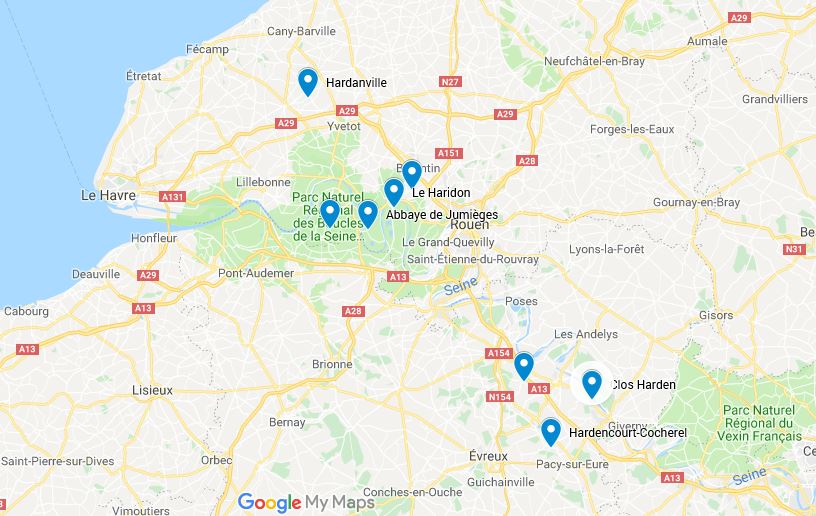
D'après les dictionnaires topographiques de la Seine-Maritime et de l’Eure :
- A Berville, on peut au moins remonter jusqu’en 1489. La sente du Haridon donnait aussi sur Anneville (1614), paroisse limitrophe. En traversant la Seine, on trouve aussi « Le Haridon » en 1599 à Saint-Pierre de Varengeville.
- Plus en amont de l’estuaire, à Ailly (seigneurie du Vaudreuil), Paul Goujon a trouvé trace de cette dénomination « Le Haridon » en 1512.
Une toponymie anglo-normande ?
Dans le cartulaire de l’abbaye de Jumièges en Normandie, on trouve un « clos de Hardene » en 1187 à Saint-Pierre de Longueville (évoluant en « clos Harden » en 1525, « clos de Hardent » en 1790 et actuellement « Le Clos Ardan »).

(Extrait de l’index en français, le document original est en latin)
Pas très loin se trouve l’actuel Hardencourt.

J’ai aussi relevé Hardanville qui s’écrivait Hardenvilla vers 1060, Hardonvilla (1153), Hardenville (1361).
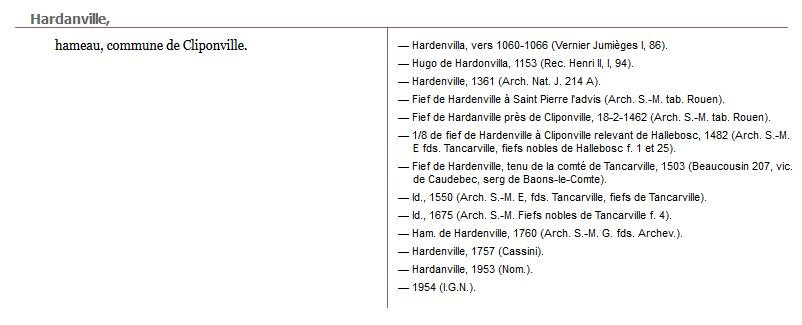
Autre découverte intéressante : on trouve sur gallica l’anoblissement en 1573 d’Anthoine Harden, verdier en la forêt de Brothonne.
Il se trouve que cette forêt se trouve à proximité de l’abbaye de Jumièges et des hameaux Le Haridon.
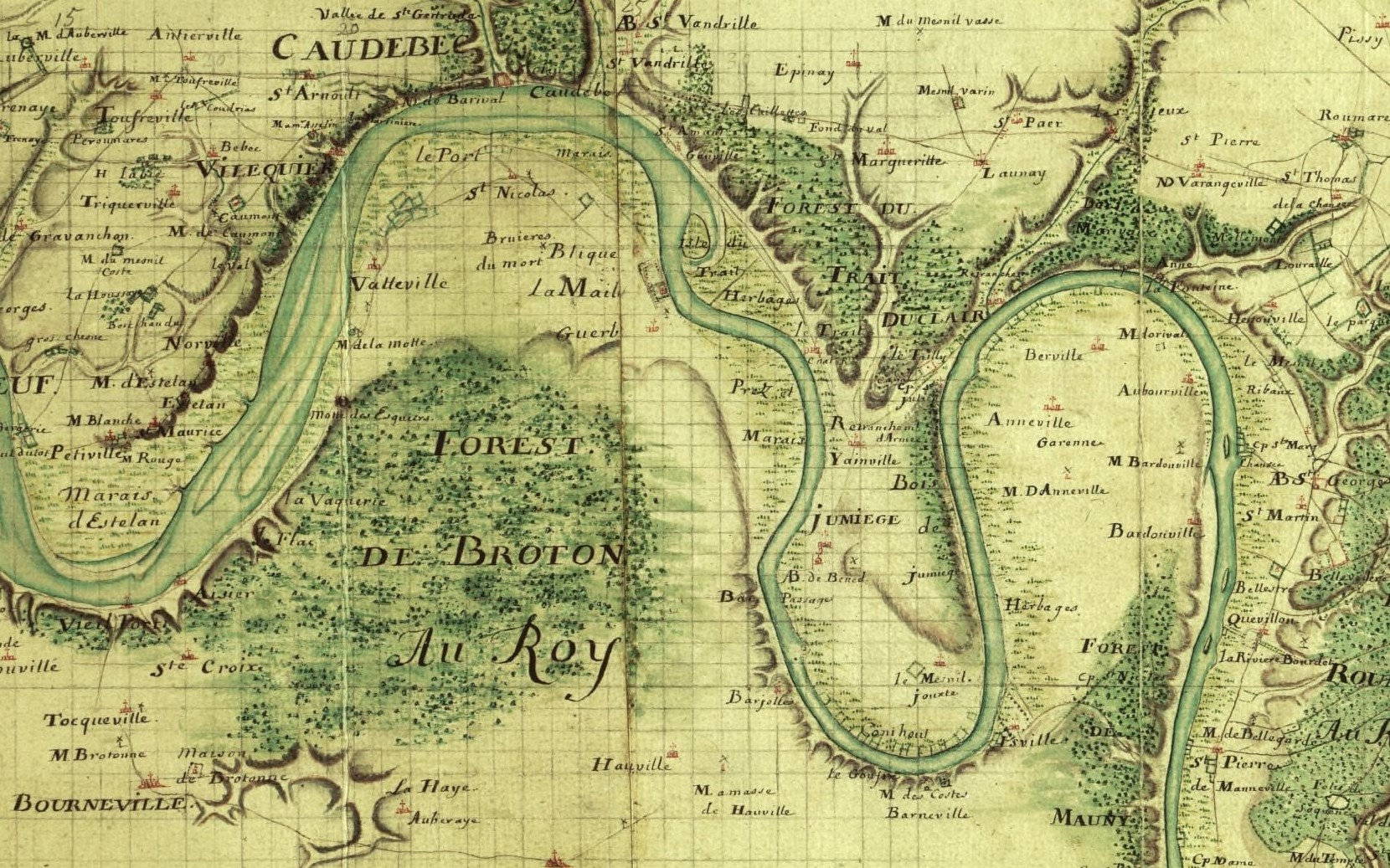
Bien cordialement,
